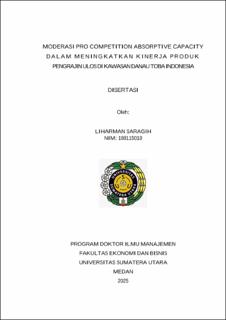| dc.description.abstract | The development of handloom weaver ulos in the Lake Toba region, Indonesia, is at an unused competitive advantage and only operates in activities related to the availability of raw materials, equipment, and labor (key resources), with the purchase and storage of raw materials, production, promotion, marketing, evaluation, and product development (key activities), partnering with thread suppliers, financial institutions, and the government (key partnerships), investment costs, expenses (cost structure), and value proposition to customers at the stage of functional benefits and practical utility. This will impact the performance of ulos products, and it is important to improve the performance of ulos products so that they are suitable in terms of function, durability, and benefits, compliance with customary specifications and traditions, aesthetics, and quality, so that ulos not only becomes a customary need but can also be modified according to market needs. This research aims to improve Product Performance (PF). New Product Development (NPD) serves as a mediation for the influence of Entrepreneurial Orientation (EO), Competitor Orientation (CO), Consumer Participation (CP), Supplier Participation (SP), and Trader Participation. (RP). The relationship between these variables is also moderated by the Pro-competition Absorptive Capacity. (Pro-cap). The type of research is sequential explanatory mix methods with the research population being handloom weaver ulos in the districts of Simalungun, Karo, Toba, Samosir, North Tapanuli, and Dairi. A sample of 305 handloom weaver was selected using purposive sampling method in the quantitative stage, while 19 people were selected in the qualitative stage. Data analysis and hypothesis testing were conducted using Structural Equation Modeling (SEM) with SmartPLS version 4, while for qualitative analysis, NVIVO version 14 was used. The hypothesis test results show that EO, SP, and RP significantly affect NPD, whereas CO and CP do not significantly affect it. When moderated by Pro-cap, EO, CO, and RP significantly affect NPD, while CP and SP do not. The influence of EO, CP, SP, and RP on PF is significant, while SP is not significant. The mediation of NPD on the influence of EO and RP on PF is significant, while CO, CP, and SP are not significant. The moderation of Pro-cap on EO, CO, and RP to NPD and PF is significant, while CP and SP are not significant. The results of the qualitative research show that artisans improve product performance through NPD, EO, RP, and also SP. Artisans do not consider other artisans as competitors. While customers interact more with traders, their role is not directly involved in the NPD of Ulos. Therefore, Pro-cap moderation has been used to absorb external information in creating motifs and designs, which were then tested to produce modified ulos products without reducing their meaning and traditional rules. Mixed-method analysis supports both quantitative and qualitative findings, namely that EO and RP significantly influence NPD and PF, while CO and SP are significant when moderated by Pro-cap. CP, in terms of its effect, remains insignificant on NPD and PF before and after being moderated by Pro-cap. | en_US |


